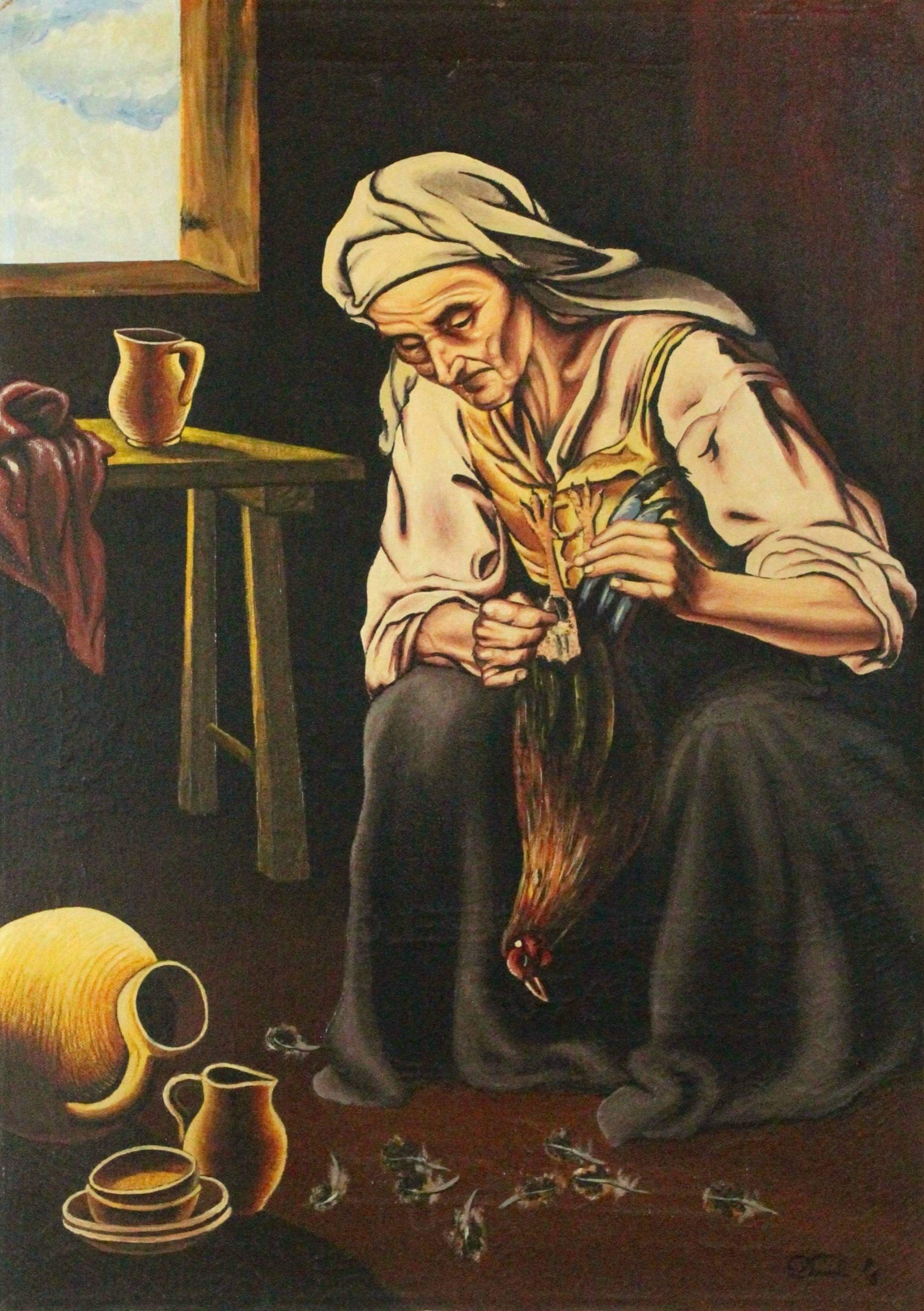THE FEATHER PLUCKER
1978, 50x70cm, Tempera on canvas with glossy spray fixative

The elderly woman who professionally plucks chickens and poultry in general takes us back in time, to when our grandmothers did work exclusively by hand. The feathers of the chickens were then preserved to fill pillows.
The work “The Feather Plucker,” created in 1978 with tempera on canvas and glossy spray fixative, is a tribute to tradition and manual work of the past. The scene, imbued with realism and intense expressiveness, portrays an elderly woman intent on plucking a rooster, immersed in a simple and authentic domestic environment.
A journey into the past:
The painting transports us to a bygone era, in which every job was done with one’s own hands, with dedication and patience. The elderly woman, with her face marked by time and her concentrated gaze, embodies the strength and wisdom of someone who has spent her life dedicated to traditional crafts. Her attire, consisting of a long skirt, a white shirt, and an apron, recalls the garments of women of the past, practical and functional.
An environment full of authenticity:
The interior of the dwelling is humble but rich in evocative details:
- An open window allows light to filter through, illuminating the scene with delicacy.
- On the rough wooden table are placed a pitcher and a red cloth, elements that add depth and realism to the composition.
- On the ground, scattered feathers testify to the toil of the work, while a large overturned jar and some cups create a sense of lived everyday life.
A symbol of tradition and memory:
The artist manages to convey not only the action of plucking but also all that it represents: a culture in which nothing was wasted, where feathers were preserved to fill pillows and blankets, and where manual work was an essential part of life.
The painting celebrates the dignity of work, telling through intense colors and decisive brushstrokes a story of resistance, dedication, and collective memory. With “The Feather Plucker,” the observer is immersed in a past time, but still vivid in our memory.

The elderly woman who professionally plucks chickens and poultry in general takes us back in time, to when our grandmothers did work exclusively by hand. The feathers of the chickens were then preserved to fill pillows.
The work “The Feather Plucker,” created in 1978 with tempera on canvas and glossy spray fixative, is a tribute to tradition and manual work of the past. The scene, imbued with realism and intense expressiveness, portrays an elderly woman intent on plucking a rooster, immersed in a simple and authentic domestic environment.
A journey into the past:
The painting transports us to a bygone era, in which every job was done with one’s own hands, with dedication and patience. The elderly woman, with her face marked by time and her concentrated gaze, embodies the strength and wisdom of someone who has spent her life dedicated to traditional crafts. Her attire, consisting of a long skirt, a white shirt, and an apron, recalls the garments of women of the past, practical and functional.
An environment full of authenticity:
The interior of the dwelling is humble but rich in evocative details:
- An open window allows light to filter through, illuminating the scene with delicacy.
- On the rough wooden table are placed a pitcher and a red cloth, elements that add depth and realism to the composition.
- On the ground, scattered feathers testify to the toil of the work, while a large overturned jar and some cups create a sense of lived everyday life.
A symbol of tradition and memory:
The artist manages to convey not only the action of plucking but also all that it represents: a culture in which nothing was wasted, where feathers were preserved to fill pillows and blankets, and where manual work was an essential part of life.
The painting celebrates the dignity of work, telling through intense colors and decisive brushstrokes a story of resistance, dedication, and collective memory. With “The Feather Plucker,” the observer is immersed in a past time, but still vivid in our memory.